Natural Area Preservation News
Protecting and restoring Ann Arbor's natural areas and fostering an environmental ethic among its citizens.
Volume 19, Number 1
Spring 2014
David Borneman
South Pond Nature Area holds some interesting stories – in terms of changes to the landscape, as well as NAP’s relationship with the often overlooked habitat that exists there. In this issue of NAP News, we have combined the Park Focus article with the Coordinator’s Corner, to take a closer look at South Pond’s past, present and future.
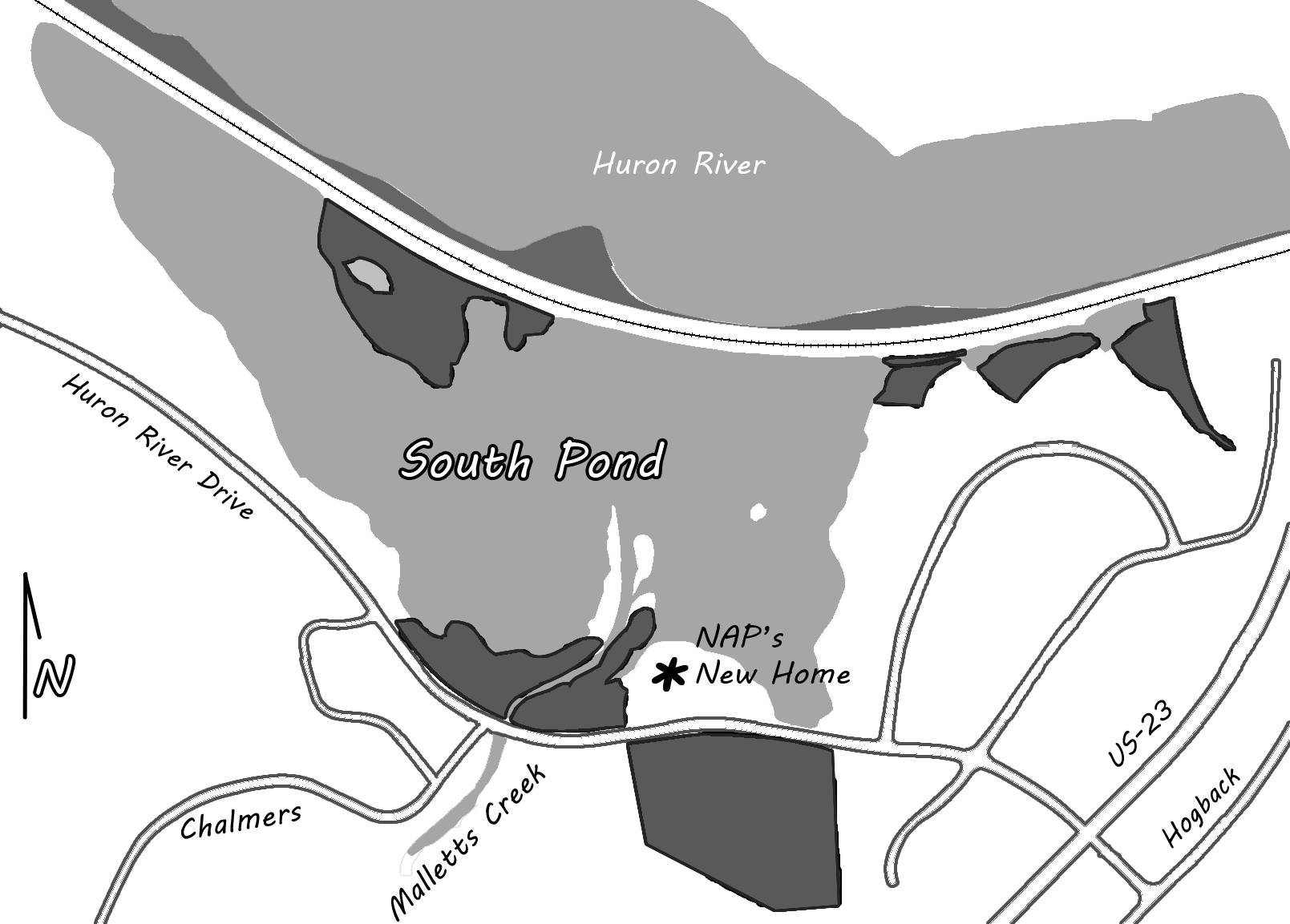
May 24, 1819 - A survey team working for the U.S. Surveyor General begins crisscrossing the land that will eventually become Ann Arbor Township, setting up a grid of 36 square mile “sections.” The mission since 1796 had been to survey all the land in the Northwest Territory (northwest of the Ohio River) recently acquired from the Native Americans. As they trudged along, they made note of when they encountered trails, streams, rivers, prairies, or other landmarks. On that particular day in late May, perhaps on a bright sunny morning with the trees full of spring migrants and beautiful bird songs, the surveyors were marching north between sections 35 and 36 in the far southeast corner of Ann Arbor Township, plotting the mile-long border. The challenge for the survey team that day was to delineate a one-mile stretch of the north-south section line, as it crossed the Huron River. That meant taking the line right up to the very edge of the riverbank, and then picking it up again on the far shore. At a distance of 30.50 chains (2013 feet) north of what would later become the corner of Hogback and Clark Roads, the surveyor entered this note into his log book, “Enter prairie.” Continuing north another 31.77 chains (2097 feet) he then noted, “Set post on Huron,” meaning that they had hit the edge of the river and placed a post there to mark the spot. This is the first known description of this particular piece of ground on the south bank of the Huron River; it was a “prairie” four-tenths of a mile wide. Today, we refer to this same patch of ground as “South Pond.”
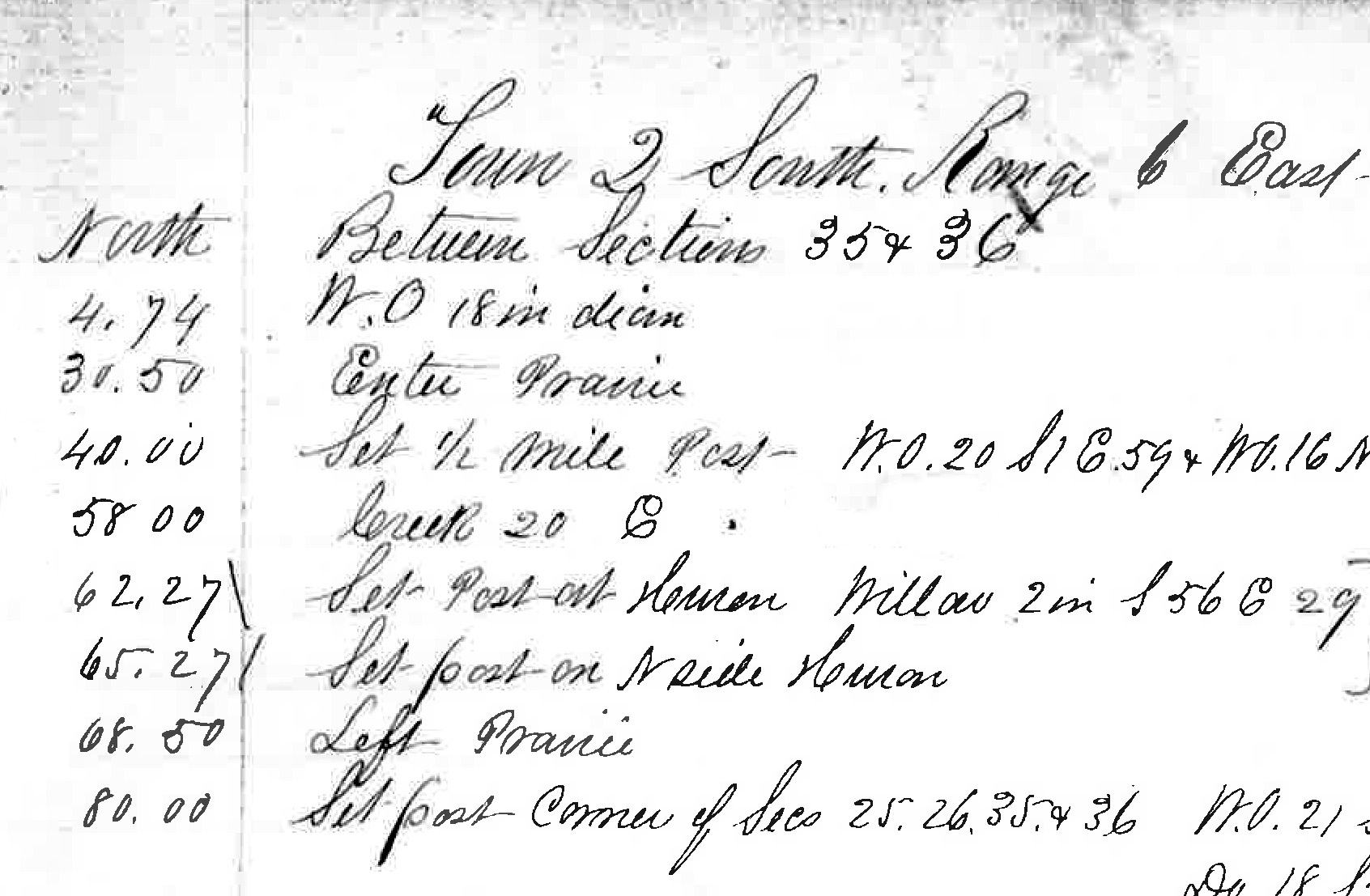
Clearly much has changed in the past 195 years. When the Dixboro Dam was built at the start of the 20th century, it flooded this “prairie,” which may have actually been closer to either a “wet prairie” or a “sedge meadow” or a “fen” ecosystem. But it certainly wasn’t a pond. “South Pond” was created by damming the river, the rising waters backing up through culverts under the railroad tracks next to the Gallup Bike Trail. This flooded the mouth of Mallett’s Creek, which drains the entire southwestern part of Ann Arbor, carrying sediment and nutrients from as far away as Briarwood Mall. Decades later, when US-23 was built and detoured around this wide, flooded part of the river, the construction re-routed Swift Run Drain so that it too emptied into South Pond, dumping its load of sediment and nutrients into the impoundment. The “prairie” noted in 1819 had now become a full-fledged “retention pond,” protecting the river from the direct hit of all the sediment and nutrients collected from these two urban watersheds, but concentrating those negative impacts instead into South Pond.
Rising above these low-lying parts of the South Pond region are several lovely little knolls often called “oak knobs.” The glacial meltwater 12,000 years ago washed away the tiny clay particles from these high spots, creating sandy soils where oaks thrive, along with other things like blueberries, little bluestem grass, and other prairie grasses and wildflowers that need open, sunny, well-drained soils. The best remaining example of these sandy oak knobs in the immediate area is on the north shore of South Pond, next to the railroad tracks. Unfortunately, this location on the “wrong side of the tracks” (and the fence!) isolates this little woodland from the many park users who use the Gallup Bike Trail. It is, however, reachable by canoe from the south shore of South Pond, along Huron River Drive, where another small oak knob exists.
This former “prairie-turned-pond” is undergoing yet another significant change: after decades of serving as a retention pond to protect the Huron River from sediment and nutrients, South Pond is turning into a marsh. Gone are many of the duck species that once dove for their food. Here now are the wading birds that hunt in the shallow waters. Whether this is good or bad depends on one’s fondness for ducks versus wading birds. It is what it is. If there is one lesson nature teaches us, it is that things are always changing. And that’s an important lesson to remember, lest we find ourselves clinging too strongly to how things used to be.
The next change at South Pond will be exciting for us at NAP: it is about to become our new home. At 3875 East Huron River Drive, on the southern oak knob, a lovely house was built in 1938, nestled amongst the large white oak trees. This year NAP, Adopt-A-Park, and GIVE 365 will relocate our offices to this house. From the large back windows overlooking South Pond, one can see across the water toward Gallup Park to the north, and the sister oak knob isolated by the railroad. Birders can enjoy over 100 species of birds that have been recorded there by NAP volunteers over the years, including many herons, egrets, night-herons, and shorebirds.
After 19 years at the Leslie Science and Nature Center, it’s time for a new home. With the growth of programming at LSNC over the years, they desperately need the office and storage space currently occupied by NAP. We have enjoyed a wonderful partnership with LSNC these many years. Many good friendships have been made. Much collaboration and synergy were enjoyed. And I personally have treasured my close kinship with the majestic walnut tree that has graced my view out the window every single morning. A big part of me wishes that NAP could stay here at LSNC. It’s been a good home for us for nearly two decades. But nothing stays the same. Things are always changing. South Pond is now our new home, or will be later this spring, as soon as all the renovations are completed. There will be new opportunities with our new home, and new challenges. We will figure out how to deal with them, and relish the newness that comes with any change.
We don’t yet have a move-in date for our new home, as the 76-year-old building needs a few updates before NAP can set up shop. Once these renovations are made, we hope to officially invite our volunteers to an Open House to celebrate the start of the next chapter in the story of NAP. Watch this space!
Well over 100 species are known to use the small pond area south of the river during migration and breeding season. The site is reliable for Caspian Tern in the late summer and early fall. The most common shorebirds—Greater and Lesser Yellowlegs, Spotted and Solitary Sandpiper—can be seen on the sand bar that forms near the Chalmers Creek mouth. Double-crested Cormorant is often seen here as well. The site is also dependable for herons, Great Blue, Green and the stately Great Egret. More recently, Black-crowned Night Herons have been found by patient birdwatchers who scan the shrubs along the edges.
Former NAP Botanist, Bev Walters, looks back at NAP’s significant finds at South Pond.
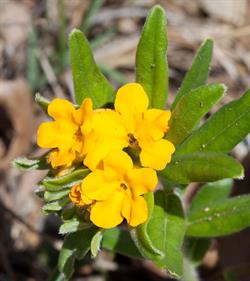
SOUTH POND OAK KNOB
I first learned about South Pond North from volunteer Joan Doman back in 1994. She was working on a plant list for the site and had found some interesting species. We met up at the oak knob along the railroad tracks on the north shore of South Pond and beat our way through the interior, which was very overgrown with dogwood and honeysuckle. I wasn't very optimistic at first, but when we emerged into the open area by the railroad tracks I thought the area held more promise. In addition to wild lupine (Lupinus perennis) and hoary puccoon (Lithospermum canascens), big-bluestem and Indian grass were present. I subsequently learned that some rare plants were known from the area [(Leiberg's panic grass (Dichanthelium leibergii) and white gentian (Gentiana alba)]. With intensive invasive shrub removal and prescribed fire, the shrubby forest was transformed into an open savanna with a small prairie thriving along the railroad tracks. This is one site I always enjoy revisiting because I often find prairie or savanna species emerging that weren't there during our original surveys.
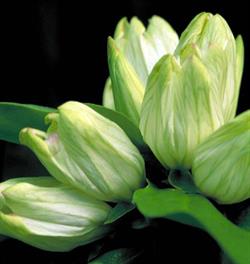
SOUTH POND WETLAND
While first walking the site I noticed the central portion of the wetland was infested with purple loosestrife, but some areas of high-quality vegetation were hanging on, including a large population of the rare hairy-fruited sedge (Carex trichocarpa). One day I recall finding myself face to face with a large Michigan lily (Lilium michiganense) in full bloom. The American highbush-cranberry (Viburnum trilobum) growing in the wetlands was unexpected because it is much less common locally than the European highbush-cranberry (Viburnum opulus). Upland areas are home to some uncommon plants too - the yellow-pimpernel (Taenidia integerrima) and the round-leaved ragwort (Packera obovata).
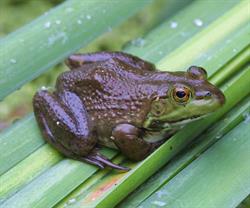
As early as March, male chorus frogs and spring peepers can be heard calling from the marshes as they search for mates and, soon after, their larva can be found in the shallows. Other species’ choruses can be heard later in the year such as the low-melodic trill of the gray tree frog and the low-pitch bass of the American bullfrog. Eastern American toads and green frogs also make their homes in this landscape.
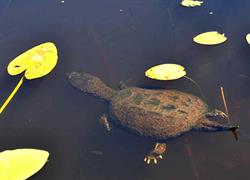
THE MICHIGAN STATE REPTILE, the painted turtle, is regularly observed basking and snapping turtles are occasionally seen searching for places to nest. Perhaps the most remarkable species observed in this area is the queen snake. Queen snakes are a light brown to beautiful steel gray with light-yellow bellies. Three darks stripes extend down its sides and back, and four dark stripes extend down its belly. These stripes aptly give this species the name Regina septemvittata, meaning “queen with seven stripes”.
This year when you volunteer with NAP, make sure to get your card punched! Collect three punches (at three different kinds of activities) to win a prize at the Annual Volunteer Appreciation Potluck. The more punches you collect (for different kinds of activities) the bigger the prizes! Try some new activities, all listed on the back of the card. Cards will be available at all NAP events (don’t worry if you forget your card—you can collect punches on more than one card).
Volunteer opportunities are listed on our website: http://www.a2gov.org/NAP, on our Facebook page: http://facebook.com/ann.arbor.NAP and in the newsletter. For more information contact NAP at 734.794.6627 or
[email protected].
 Patrick Terry, Herpetologist
Patrick Terry, Herpetologist Since my time as an Eagle Scout in Alaska I have been devoted to conservation. I am a graduate student at Eastern Michigan University, where I am researching the origin of Michigan’s red-eared slider turtle. I am excited for my future work with Ann Arbor’s amphibians and reptiles.
 Brandon Besteman, Field Crew
Brandon Besteman, Field Crew I grew up in the Grand Rapids area and graduated from Cornerstone University with a BS in Environmental Biology. For the past year and a half I worked in North Carolina for The Nature Conservancy. I am glad to be back in Michigan and to have the opportunity to work for NAP.
 Kevin Erdmann, Field Crew
Kevin Erdmann, Field Crew I am a graduate of the University of Michigan with a BA in environmental studies. Since graduation I have worked for the Huron-Clinton Metropolitan Authority and the Matthaei Botanical Gardens. I am excited for the opportunity to gain more ecological restoration experience in Ann Arbor’s beautiful natural areas.
Staff Updates: Farewell...
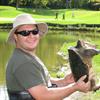 David Mifsud, Herpetologist
David Mifsud, Herpetologist A lot has changed since I started here almost 14 years ago and I am proud of what we accomplished. My company, Herpetological Resource Management, has grown to be a significant contributor to Michigan herp conservation, limiting the time I can spend with NAP. It has been an honor and privilege being the City’s herpetologist. I’m excited to pass the torch over to Patrick, a dedicated and passionate individual. I look forward to continuing to support NAP in a consulting role.
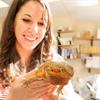 Anat Belasen, Field Biologist
Anat Belasen, Field Biologist I have truly enjoyed working to monitor and protect our local herpetofauna. I have begun a PhD in Ecology and Evolutionary Biology at the University of Michigan, in which I am studying amphibians in the Atlantic Forest of Brazil. I hope to remain involved with NAP, and plan to continue to do my part to educate the public about the important roles herps play in ecosystems and broader conservation.
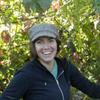 Penelope Richardson-Bristol
Penelope Richardson-Bristol My time at NAP was far too short and I already miss my position as the Workday Coordinator! I enjoyed working with and learning from all of the staff and dedicated volunteers. While I am not currently living in Ann Arbor, I still plan to come back to volunteer whenever I get a chance.
-
Brooks Curtis - Sunset Brooks Nature Area
-
Brian Derstine - Cedar Bend Nature Area
-
Tim Furbacher - Bluffs Nature Area
-
Curtis Vincze - Huron Hills Golf Course
-
Jim Vincze - Huron Hills Golf Course
-
Jeff Vornhagen - Leslie Woods Nature Area
Many thanks to the groups who volunteered with NAP recently. We could not make such a difference without you!
-
Dicken Elementary School
-
Emerson School
-
EMU Bio 226
-
EMU Vision
-
EMU Wetlands Bio 413/513
-
UM Econ 108
-
UM Triangle Fraternity
SATURDAY, MAY 3, 2014, 10 A.M TO 1 P.M.
Garlic Mustard Weed-Out Day (GMWOD) is an annual celebration in which volunteers hand-pull invasive garlic mustard in natural areas all around Ann Arbor! Garlic mustard is an aggressive invasive plant which can quickly crowd out native foliage and decrease species diversity in the woods. Identifying and pulling garlic mustard is fun and easy for all ages, so this is a great volunteer opportunity for families!
GARLIC MUSTARD WEED-OUT DAY 2014 PARTICIPATING PARKS:
ARGO NATURE AREA- Meet in the Argo Canoe Livery parking lot near the entrance to the woods. 1055 Longshore Drive.
BIRD HILLS NATURE AREA - Meet at the Bird Road entrance, west of Huron River Drive (additional parking at the Barton Nature Area Dam entrance).
CEDAR BEND NATURE AREA - Meet us at the Island Park parking lot, at the end of Island Drive, just northeast (and across the river from) Fuller Rd and Maiden Lane.
HANNAH NATURE AREA - Meet at the west end of Bath Street, west of 7th (between Miller and Huron).
MILLER NATURE AREA - Meet us at the Arborview Boulevard entrance, just east of Wildwood Avenue.
LESLIE WOODS - Meet at the north end of Upland Drive, just north of Plymouth Road.
